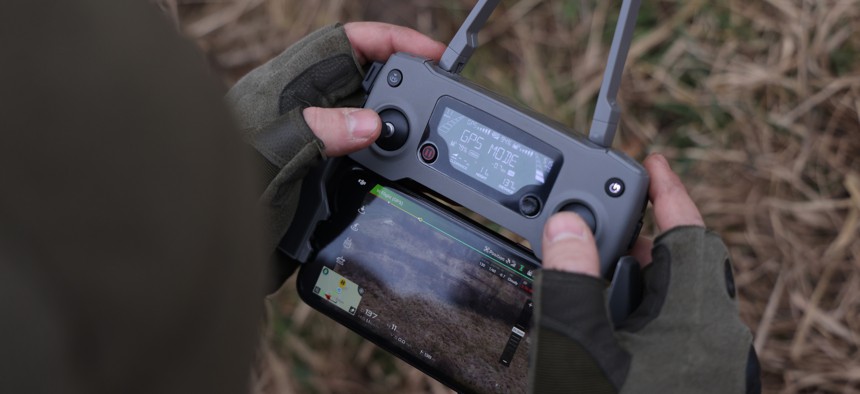
A participant in a combat training day uses a drone to spot colleagues pretending to be enemy snipers. The event was hosted by TSEL, a local paramilitary civil formation on February 22, 2023, in Ukraine's Lviv region. Sean Gallup/Getty Images
Come Test Your Gear Against Russian Forces, Ukrainians Urge US Defense Firms
That’s just one request by special operators at a SOF conference in Florida.
FORT WALTON, Florida–U.S. defense manufacturers should bring their gear to Ukraine to try it out against an enemy that is more agile than generally perceived, Ukrainian special operators said at a SOF conference.
At least in the electronic spectrum, the war in Ukraine is constantly changing as both sides develop new ideas and countermeasures daily, the operators said, inviting U.S. firms to test their equipment in real battle zones.
This is the “right time,” one Ukrainian military official said, “to find weaknesses and to determine solutions and how to deal with Russian [electronic warfare] systems. Because, in the future, you will have the same problem.”
That’s hardly all that Ukrainians at the Special Air Warfare Symposium here said they’d like to have as their fight against Russian invaders moves into its second year. Beyond the requests for fighter jets and ATACMS missiles that get the headlines, they want attack helicopters and smaller items such as jam-resistant drones, electronic warfare equipment, and newer night vision goggles.
They also urgently want satellite communications options beyond the Starlink terminals produced by Elon Musk’s SpaceX company. Though Starlink continues to provide invaluable service, the terminals have various tactical limitations. Their connection speeds are very uneven in combat zones, and they can’t be used at all in occupied areas, a second operator said. As well, Russian forces have been aggressively targeting the terminals’ signals; as a result, Ukrainian forces rarely use them in combat, they said. Finally, they want satcom gear that doesn’t rely on the mercurial Musk.
Another ask: drones that can withstand Russian electromagnetic-warfare attacks.
“We have different types of drones but…but the company cannot make mass production in a short period of time. And because of changing tactics and Russian equipment, you're always a little bit behind. So in order to be competitive with them, it should be faster” one operator said.
Russian EW has limited Ukrainian drones to the L5 frequency band, and “we don’t know when they will create the jamming even for this,” they said.
They also want directional antennas to protect drone operators from being detected by Russian forces. Currently, they use a small device to hide drone operators from Russian signal detectors and often place the antenna far away from the operator. “But you can not completely hide the emission of the antenna,” they said.
They also requested Western attack helicopters and advanced night vision systems for their pilots. “We extremely need attack helicopters,” said one.
They described the difficult job Ukrainian helicopter pilots have evading advanced Russian jets. They said Ukrainian helicopters have difficulty evading Russian jets. “The problem is they can see us from the range of 450 kilometers,” the operator said. The Russians will “let us approach closer and they start shooting from the range 300 kilometers. From 300 kilometers until they hit our helicopters, it's approximately 40 to 45 seconds.”
They said they had developed countermeasures for this, flying in erratic patterns. But better helicopters, such as Black Hawks and Apaches, would better enable that sort of maneuvering.
Some 31 percent, or $23.5 billion, of the $78.8 billion that the United States has awarded to Ukraine has been in the form of weapons and other pieces of military equipment. But most U.S. contractors have been reluctant to send support personnel into the country. Exceptions include IT contractors such as Palantir.
The operators said U.S. weapons makers have an opportunity to refine products in Ukraine against a real, high-tech adversary.
“This is the right time to test all equipment in Ukraine because it will be combat-proofed” one said. Compared to previous conflicts such as Iraq and Afghanistan, “This is totally different way of war which we have right now.”
Sam Skove contributed to this post.




